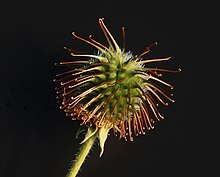
An invasive species is an introduced species that harms its new environment. Invasive species adversely affect habitats and bioregions, causing ecological, environmental, and/or economic damage. The term can also be used for native species that become harmful to their native environment after human alterations to its food web. Since the 20th century, invasive species have become a serious economic, social, and environmental threat worldwide.

Urban ecology is the scientific study of the relation of living organisms with each other and their surroundings in an urban environment. An urban environment refers to environments dominated by high-density residential and commercial buildings, paved surfaces, and other urban-related factors that create a unique landscape. The goal of urban ecology is to achieve a balance between human culture and the natural environment.

In population genetics, gene flow is the transfer of genetic material from one population to another. If the rate of gene flow is high enough, then two populations will have equivalent allele frequencies and therefore can be considered a single effective population. It has been shown that it takes only "one migrant per generation" to prevent populations from diverging due to drift. Populations can diverge due to selection even when they are exchanging alleles, if the selection pressure is strong enough. Gene flow is an important mechanism for transferring genetic diversity among populations. Migrants change the distribution of genetic diversity among populations, by modifying allele frequencies. High rates of gene flow can reduce the genetic differentiation between the two groups, increasing homogeneity. For this reason, gene flow has been thought to constrain speciation and prevent range expansion by combining the gene pools of the groups, thus preventing the development of differences in genetic variation that would have led to differentiation and adaptation. In some cases dispersal resulting in gene flow may also result in the addition of novel genetic variants under positive selection to the gene pool of a species or population

An ecosystem engineer is any species that creates, significantly modifies, maintains or destroys a habitat. These organisms can have a large impact on species richness and landscape-level heterogeneity of an area. As a result, ecosystem engineers are important for maintaining the health and stability of the environment they are living in. Since all organisms impact the environment they live in one way or another, it has been proposed that the term "ecosystem engineers" be used only for keystone species whose behavior very strongly affects other organisms.

Habitat fragmentation describes the emergence of discontinuities (fragmentation) in an organism's preferred environment (habitat), causing population fragmentation and ecosystem decay. Causes of habitat fragmentation include geological processes that slowly alter the layout of the physical environment, and human activity such as land conversion, which can alter the environment much faster and causes the extinction of many species. More specifically, habitat fragmentation is a process by which large and contiguous habitats get divided into smaller, isolated patches of habitats.

In spermatophyte plants, seed dispersal is the movement, spread or transport of seeds away from the parent plant. Plants have limited mobility and rely upon a variety of dispersal vectors to transport their seeds, including both abiotic vectors, such as the wind, and living (biotic) vectors such as birds. Seeds can be dispersed away from the parent plant individually or collectively, as well as dispersed in both space and time. The patterns of seed dispersal are determined in large part by the dispersal mechanism and this has important implications for the demographic and genetic structure of plant populations, as well as migration patterns and species interactions. There are five main modes of seed dispersal: gravity, wind, ballistic, water, and by animals. Some plants are serotinous and only disperse their seeds in response to an environmental stimulus. These modes are typically inferred based on adaptations, such as wings or fleshy fruit. However, this simplified view may ignore complexity in dispersal. Plants can disperse via modes without possessing the typical associated adaptations and plant traits may be multifunctional.
Colonisation or colonization is the spread and development of an organism in a new area or habitat. Colonization comprises the physical arrival of a species in a new area, but also its successful establishment within the local community. In ecology, it is represented by the symbol λ to denote the long-term intrinsic growth rate of a population.

Myrmecochory ( ; from Ancient Greek: μύρμηξ, romanized: mýrmēks and χορεία khoreíā is seed dispersal by ants, an ecologically significant ant–plant interaction with worldwide distribution. Most myrmecochorous plants produce seeds with elaiosomes, a term encompassing various external appendages or "food bodies" rich in lipids, amino acids, or other nutrients that are attractive to ants. The seed with its attached elaiosome is collectively known as a diaspore. Seed dispersal by ants is typically accomplished when foraging workers carry diaspores back to the ant colony, after which the elaiosome is removed or fed directly to ant larvae. Once the elaiosome is consumed, the seed is usually discarded in underground middens or ejected from the nest. Although diaspores are seldom distributed far from the parent plant, myrmecochores also benefit from this predominantly mutualistic interaction through dispersal to favourable locations for germination, as well as escape from seed predation.

A seagrass meadow or seagrass bed is an underwater ecosystem formed by seagrasses. Seagrasses are marine (saltwater) plants found in shallow coastal waters and in the brackish waters of estuaries. Seagrasses are flowering plants with stems and long green, grass-like leaves. They produce seeds and pollen and have roots and rhizomes which anchor them in seafloor sand.
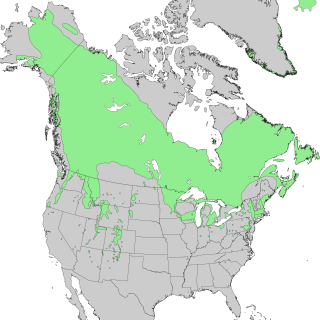
Species distribution, or speciesdispersion, is the manner in which a biological taxon is spatially arranged. The geographic limits of a particular taxon's distribution is its range, often represented as shaded areas on a map. Patterns of distribution change depending on the scale at which they are viewed, from the arrangement of individuals within a small family unit, to patterns within a population, or the distribution of the entire species as a whole (range). Species distribution is not to be confused with dispersal, which is the movement of individuals away from their region of origin or from a population center of high density.
In landscape ecology, landscape connectivity is, broadly, "the degree to which the landscape facilitates or impedes movement among resource patches". Alternatively, connectivity may be a continuous property of the landscape and independent of patches and paths. Connectivity includes both structural connectivity and functional connectivity. Functional connectivity includes actual connectivity and potential connectivity in which movement paths are estimated using the life-history data.
Source–sink dynamics is a theoretical model used by ecologists to describe how variation in habitat quality may affect the population growth or decline of organisms.
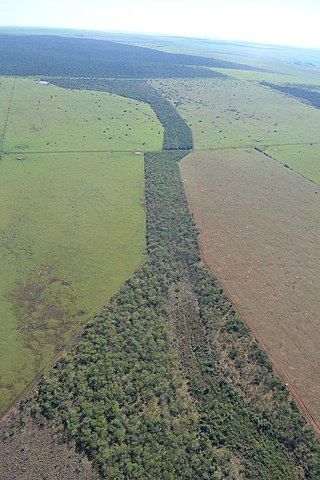
A wildlife corridor, habitat corridor, or green corridor is an area of habitat connecting wildlife populations separated by human activities or structures, allowing the movement of individuals between populations, that may help prevent negative effects of inbreeding and reduced genetic diversity that can occur within isolated populations. Corridors also help facilitate the re-establishment of populations that have been reduced or eliminated due to random events and may moderate some of the worst effects of habitat fragmentation, through urbanization that splits up habitat areas, causing animals to lose both their natural habitat and the ability to move between regions to access resources. Habitat fragmentation due to human development is an ever-increasing threat to biodiversity, and habitat corridors serve to manage its effects.
A genetic isolate is a population of organisms that has little to no genetic mixing with other organisms of the same species due to geographic isolation or other factors that prevent reproduction. Genetic isolates form new species through an evolutionary process known as speciation. All modern species diversity is a product of genetic isolates and evolution.
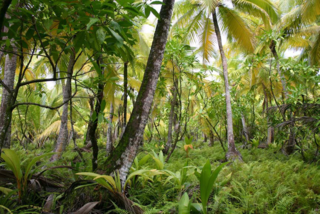
Plant ecology is a subdiscipline of ecology that studies the distribution and abundance of plants, the effects of environmental factors upon the abundance of plants, and the interactions among plants and between plants and other organisms. Examples of these are the distribution of temperate deciduous forests in North America, the effects of drought or flooding upon plant survival, and competition among desert plants for water, or effects of herds of grazing animals upon the composition of grasslands.
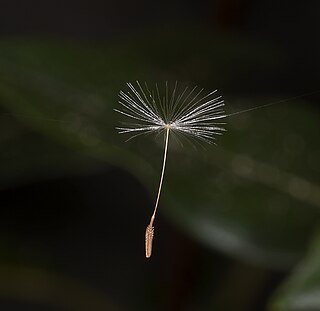
A dispersal vector is an agent of biological dispersal that moves a dispersal unit, or organism, away from its birth population to another location or population in which the individual will reproduce. These dispersal units can range from pollen to seeds to fungi to entire organisms.

Forest migration is the movement of large seed plant dominated communities in geographical space over time.
Microbial biogeography is a subset of biogeography, a field that concerns the distribution of organisms across space and time. Although biogeography traditionally focused on plants and larger animals, recent studies have broadened this field to include distribution patterns of microorganisms. This extension of biogeography to smaller scales—known as "microbial biogeography"—is enabled by ongoing advances in genetic technologies.
Diplochory, also known as “secondary dispersal”, “indirect dispersal” or "two-phase dispersal", is a seed dispersal mechanism in which a plant's seed is moved sequentially by more than one dispersal mechanism or vector. The significance of the multiple dispersal steps on the plant fitness and population dynamics depends on the type of dispersers involved. In many cases, secondary seed dispersal by invertebrates or rodents moves seeds over a relatively short distance and a large proportion of the seeds may be lost to seed predation within this step. Longer dispersal distances and potentially larger ecological consequences follow from sequential endochory by two different animals, i.e. diploendozoochory: a primary disperser that initially consumes the seed, and a secondary, carnivorous animal that kills and eats the primary consumer along with the seeds in the prey's digestive tract, and then transports the seed further in its own digestive tract.

Migration, in ecology, is the large-scale movement of members of a species to a different environment. Migration is a natural behavior and component of the life cycle of many species of mobile organisms, not limited to animals, though animal migration is the best known type. Migration is often cyclical, frequently occurring on a seasonal basis, and in some cases on a daily basis. Species migrate to take advantage of more favorable conditions with respect to food availability, safety from predation, mating opportunity, or other environmental factors.





